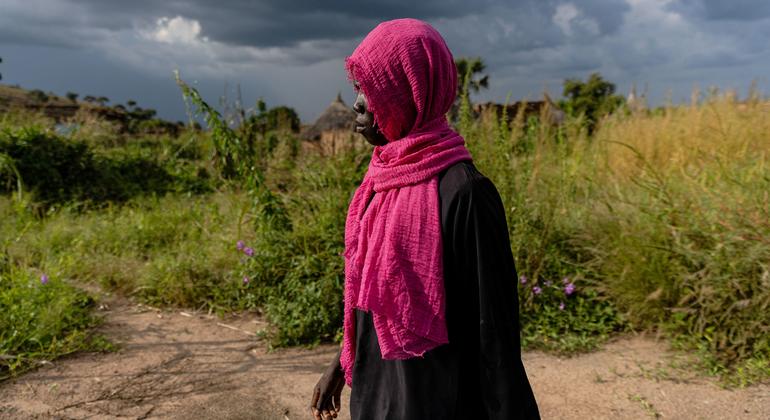Juliette Touma, communications director of the United Nations Agency for Palestine refugees, UNRWAVisited Gaza several times during and before the war and thought about the children she met there and in other areas of conflict.
“Adam has been in my mind lately, more than usual.
I met Adam years ago in the Yemenite port city of Hudaydah, at the time under siege and heavy bombardment. In the very poor district of the hospital, there were Adam, 10, weighing a little more than 10 kilograms. He couldn’t speak, he couldn’t cry. Everything he could do was to make a hoarse sound of breathing. A few days later, Adam died of malnutrition.
A child suffering from malnutrition inside a Sanaa hospital, Yemen.
Deadly malnutrition
A few years before that, my colleague Hanaa called from Syria late at night. She was in tears and could barely say a word. Hanaa finally told me that Ali, a 16 -year -old boy died. In yet another besieged city, taken in a war and not of its manufacture, he was also dead of malnutrition.
The next morning, my supervisor, an epidemiologist, said: “For a 16 -year -old boy, dying of malnutrition, says a lot. He is practically a man. This means that there is no food at all in this part of Syria. ”
Back in Yemen in one of the rare hospitals for functional children in the Sanaa capital, I walked in the children’s district during the top of a cholera epidemic. Boys aged 15 and 16 have trouble staying alive.
They were so weak and emaciated that they could barely turn into their beds.
These images and stories haunted me over the years as they have done for many of us who have worked in severe hunger or situations of famine.
The author plays with students who take advantage of the “Summer Fun Weeks” games in a UNRWA school in the Gaza Strip in 2023. (File)
Mortal hunger grows in Gaza
In 2022, when I had the great pleasure of returning and leaving Gaza, I visited the children in the UNRWA schools. Immaculation dressed, healthy, smiling, eager to learn, jumping from top to bottom in the school field to the sound of music.
At the time, Gaza was already under a blockade for more than 15 years. Food was however available on the markets by imports via Israel and locally farmed products. UNRWA also provided food aid to more than a million people.
Images of Adam and Ali were quickly pushed to the back of my memory until a few weeks ago, when they suddenly reappear.
An increasing number of children are projected for malnutrition in Gaza.
Babies can survive, but will they do it?
Our Gaza teams began to send alarming photos of emaciated babies. Malnutrition rates increase rapidly, spreading through the Gaza strip. According to the World Health Organization (WHO), more than 50 children have died in malnutrition since the start of the siege on March 2.
UNRWA has projected more than 242,000 children into the agency’s clinics and medical points through the war torn by the war, covering more than half of children under the age of five in Gaza. One in 10 in 10 children is poorly nourished.
Ahlam has seven months. His family has been moved every month since the start of the war, looking for non -existent security. Shocked and her body weakens, the Ahlam is seriously poorly nourished. Like many babies in Gaza, its immune system has been damaged by trauma, constant forced displacement, lack of clean water, poor hygiene and very little food.
Ahlam can survive, but will it do it?
Rare bombs and supplies
There are very few therapeutic supplies to treat children with malnutrition because the bases are rare in Gaza. The Israeli authorities have imposed a tight seat blocking the entry of food, medication, medical supplies and nutritional and hygiene materials, including soap.
While the headquarters are sometimes attenuated, UNRWA (the largest humanitarian organization in Gaza) has not been authorized to provide humanitarian assistance since March 2.
Last week, Salam, another baby suffering from malnutrition, died. She was a few months old. When she finally reached the UNRWA clinic, it was too late.
Meanwhile, eight children queue for therapeutic support against malnutrition were killed when Israeli forces hit the clinic in which they were. One of my colleagues who led to the clinic a few minutes later told me that she had seen mothers looking in the abyss, crying in silence, just like Adam.
How many babies should die before the world takes measures?
Why should babies die of malnutrition in the 21st century, especially when it is completely avoidable?
At UNRWA, we have more than 6,000 food trucks, hygiene supplies and drugs outside Gaza while waiting for the green light to between.
Help will mainly help little girls like Ahlam. UNRWA also has more than 1,000 health workers who can provide boys and girls with specialized nutritional services.
In the middle of the daily distribution of horrors that we get Gaza on our screens, we can’t help but ask how many Hlam and salam must die before acting?
How long until a ceasefire is reached for bombs to stop falling on emaciated and dying children? »»
Originally published at Almouwatin.com








